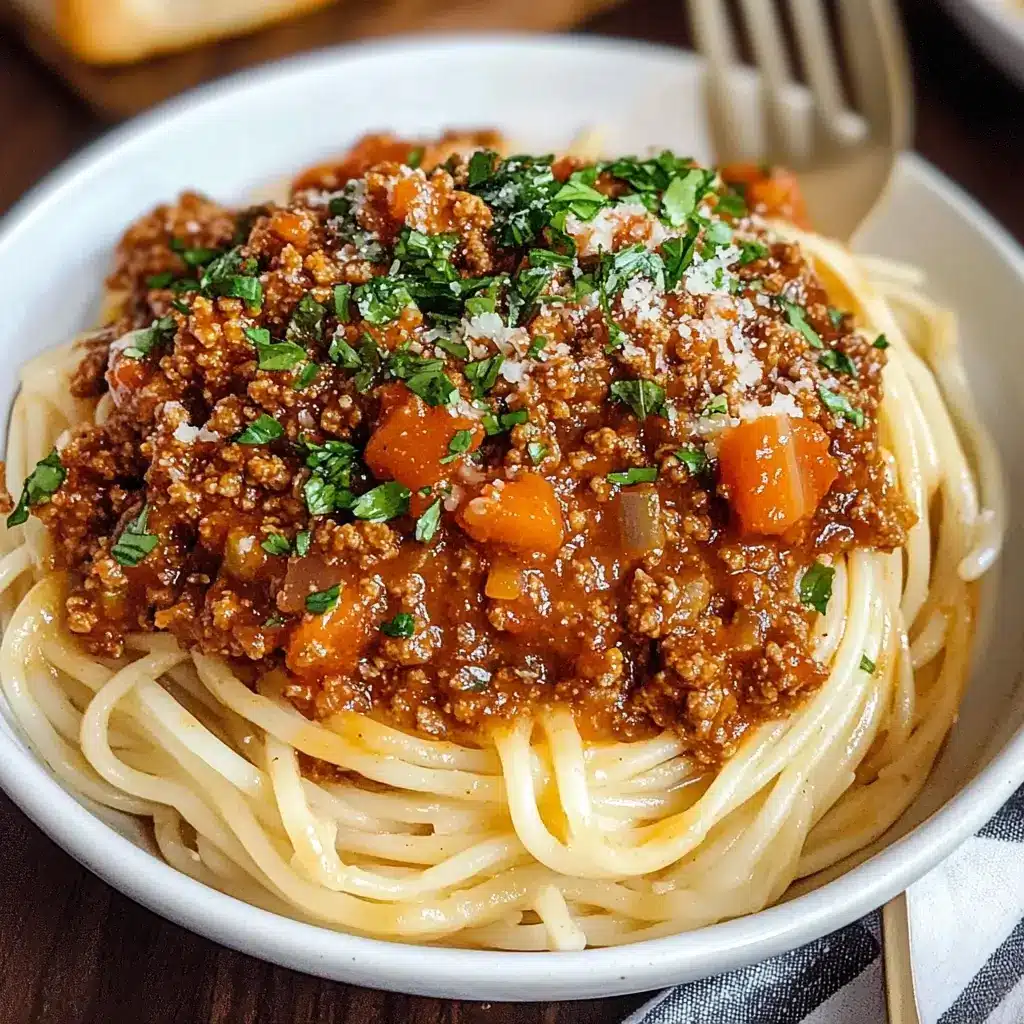It’s one of those recipes that has become an absolute cornerstone in our household, a culinary hug that wraps everyone in warmth and satisfaction. The first time I decided to venture into the world of vegetarian Bolognese, I’ll admit, there was a healthy dose of skepticism, especially from the more traditional meat-eaters in my family. Could a plant-based sauce truly capture the rich, savory depth of its classic counterpart? The answer, as we discovered with delightful surprise, was a resounding YES! This particular Vegetarian Bolognese recipe has since been tweaked and perfected over countless Sunday dinners and weekday quick-fixes. The beauty of it lies in its hearty texture, derived from a clever combination of lentils and finely minced mushrooms, simmered slowly with aromatic vegetables and a robust tomato base. It’s so satisfying that even my most carnivorous friends ask for the recipe. My kids, who can be notoriously picky, now request “that yummy lentil spaghetti” regularly. It’s a winner because it’s not just a substitute; it’s a star in its own right – deeply flavorful, incredibly nutritious, and surprisingly easy to whip up a big batch of for comforting meals throughout the week. This isn’t just food; it’s a testament to how vibrant and fulfilling plant-based eating can be.
The Enduring Appeal of Bolognese: A Veggie Renaissance
Bolognese sauce, originating from Bologna, Italy, is traditionally a slow-cooked meat sauce, rich and deeply flavored, typically served with tagliatelle. Its comforting nature and complex taste profile have made it a global favorite. However, as dietary preferences evolve and more people embrace plant-based eating for health, ethical, or environmental reasons, the demand for a worthy vegetarian alternative has soared. This Vegetarian Bolognese recipe rises to that challenge, offering all the comforting, savory goodness without the meat.
The magic lies in replicating the key characteristics of traditional Bolognese:
- Umami: The savory “fifth taste” is crucial. In this recipe, mushrooms, tomato paste, soy sauce (or tamari), and nutritional yeast work together to create that deep, satisfying savoriness.
- Texture: Finely chopped mushrooms and hearty lentils provide a “meaty” texture that mimics the ground meat in a classic Bolognese.
- Richness: A slow simmer allows the flavors to meld and deepen, creating a sauce that feels luxurious and substantial.
This recipe isn’t about merely omitting meat; it’s about thoughtfully building layers of flavor and texture using the best of the plant kingdom.
Ingredients for Our Ultimate Vegetarian Bolognese
This recipe is designed to serve 6-8 people, making it perfect for family dinners or meal prepping.
- For the Aromatics & Base:
- 3 tablespoons olive oil
- 2 large yellow onions, finely chopped
- 3 medium carrots, peeled and finely diced
- 3 celery stalks, finely diced
- 6-8 cloves garlic, minced
- 1 pound (about 450g) cremini or portobello mushrooms, finely chopped (a food processor works well for this, pulse until coarse crumbs)
- For the “Meaty” Element & Sauce:
- 1 ½ cups dried green or brown lentils, rinsed thoroughly
- 1 cup dry red wine (optional, but adds depth; use vegetable broth if omitting)
- 2 (28-ounce / 794g each) cans crushed San Marzano or good-quality crushed tomatoes
- 1 (6-ounce / 170g) can tomato paste
- 4 cups vegetable broth (low sodium preferred)
- 2 bay leaves
- For Flavor & Seasoning:
- 2 teaspoons dried oregano
- 1 teaspoon dried thyme
- 1 teaspoon dried basil (or ¼ cup fresh, added at the end)
- 2 tablespoons nutritional yeast (for a cheesy, umami flavor)
- 1-2 tablespoons soy sauce or tamari (for depth and umami)
- 1 tablespoon balsamic vinegar (added at the end for brightness)
- 1 teaspoon smoked paprika (optional, for a hint of smokiness)
- Salt and freshly ground black pepper to taste
- Pinch of red pepper flakes (optional, for a little heat)
- For Serving (Optional):
- Fresh basil or parsley, chopped
- Vegan Parmesan cheese or regular Parmesan cheese (if not strictly vegan)
- Your favorite pasta (tagliatelle, pappardelle, spaghetti, or rigatoni work well)
Step-by-Step Instructions for Perfect Vegetarian Bolognese
Follow these instructions carefully to build layers of flavor for an incredibly satisfying sauce.
- Sauté the Aromatics (Mirepoix):
Heat the olive oil in a large, heavy-bottomed pot or Dutch oven over medium heat. Add the chopped onions, carrots, and celery (the mirepoix). Cook, stirring occasionally, for 10-12 minutes, or until the vegetables are softened and the onions are translucent. This slow cooking builds a crucial flavor base. - Add Garlic and Mushrooms:
Add the minced garlic and cook for another 1-2 minutes until fragrant, being careful not to burn it. Stir in the finely chopped mushrooms. Cook, stirring occasionally, for 8-10 minutes, or until the mushrooms have released their liquid and it has mostly evaporated. The mushrooms should be nicely browned; this develops their umami flavor. - Introduce Tomato Paste and Spices:
Stir in the tomato paste, dried oregano, dried thyme, dried basil (if using dried), and smoked paprika (if using). Cook for 2-3 minutes, stirring constantly. Toasting the tomato paste and spices deepens their flavor. - Deglaze (Optional but Recommended):
If using red wine, pour it into the pot. Scrape up any browned bits from the bottom of the pot with a wooden spoon – these are packed with flavor! Let the wine simmer and reduce by about half, which should take 3-5 minutes. If not using wine, you can use a little of the vegetable broth for this step. - Add Lentils, Tomatoes, and Broth:
Add the rinsed lentils, crushed tomatoes, vegetable broth, bay leaves, nutritional yeast, and soy sauce/tamari to the pot. Stir everything together thoroughly. - Simmer to Perfection:
Bring the sauce to a gentle simmer. Once simmering, reduce the heat to low, cover the pot, and let it cook for at least 45-60 minutes, or up to 1.5 hours for even deeper flavor. Stir occasionally to prevent sticking and to ensure the lentils cook evenly. The lentils should be tender, and the sauce should have thickened. If the sauce becomes too thick during cooking, add a little more vegetable broth or water. - Final Seasoning and Finishing Touches:
Once the lentils are tender and the sauce has reached your desired consistency, remove the bay leaves. Stir in the balsamic vinegar. If using fresh basil, add it now. Taste the Bolognese and adjust seasoning with salt, freshly ground black pepper, and red pepper flakes (if desired). You might want to add a touch more soy sauce for umami or nutritional yeast for cheesiness. - Rest (Optional but Beneficial):
Like many stews and sauces, this Vegetarian Bolognese tastes even better the next day as the flavors continue to meld. If you have the time, let it cool and refrigerate overnight.
Nutrition Facts (Approximate)
- Servings: This recipe yields approximately 8 generous servings.
- Calories per serving (sauce only): Approximately 350-400 calories.
- Please note: This is an estimate. Actual nutritional values can vary based on specific ingredients used, brands, and precise measurements. This calculation does not include pasta or additional toppings like cheese.
This sauce is packed with plant-based protein from the lentils, fiber from the vegetables and lentils, and a wealth of vitamins and minerals.
Preparation and Cooking Time
Understanding the time commitment helps in planning your meal.
- Preparation Time: 25-35 minutes (includes chopping vegetables, rinsing lentils, and measuring ingredients). Using a food processor for the mushrooms and mirepoix can significantly reduce this time.
- Cooking Time: 1 hour to 1 hour 45 minutes (includes initial sautéing and the long simmer).
- Active Cooking Time: Approximately 25-30 minutes.
- Simmering Time (largely unattended): 45 minutes to 1.5 hours.
- Total Time: Approximately 1 hour 30 minutes to 2 hours 20 minutes.
While it involves a bit of simmering, much of this time is hands-off, allowing the flavors to develop beautifully.
How to Serve Your Delicious Vegetarian Bolognese
Serving this hearty sauce correctly can elevate the entire meal experience. Here are some classic and creative ways to enjoy your Vegetarian Bolognese:
- With Pasta (The Classic):
- Long, Flat Pasta: Tagliatelle or pappardelle are traditional choices for Bolognese as their wide surface area is perfect for catching the rich sauce.
- Tube-Shaped Pasta: Rigatoni, penne, or ziti are excellent options as the sauce gets trapped inside the tubes, ensuring a flavorful bite every time.
- Spaghetti: While not the most traditional pairing for a hearty Bolognese in Italy, it’s a popular choice worldwide.
- Whole Wheat or Gluten-Free Pasta: Easily adaptable to dietary needs. Cook pasta al dente according to package directions, drain (reserving a little pasta water), and toss with the Bolognese. Add a splash of reserved pasta water if needed to help the sauce adhere.
- Garnishes for an Extra Flair:
- Fresh Herbs: A generous sprinkle of freshly chopped basil or Italian parsley adds brightness and a fresh aroma.
- Cheese (Optional):
- For a traditional touch (if not vegan): Freshly grated Parmesan or Pecorino Romano.
- For a vegan option: A good quality store-bought vegan Parmesan, or a homemade cashew-based “Parmesan” (blended cashews, nutritional yeast, garlic powder, salt).
- Red Pepper Flakes: For those who like a little kick of heat.
- A Drizzle of Good Quality Olive Oil: Adds a final touch of richness.
- Beyond Pasta – Creative Serving Ideas:
- Over Polenta: Serve the rich Bolognese over creamy, soft polenta for a comforting and rustic meal.
- Stuffed Baked Potatoes or Sweet Potatoes: A hearty and nutritious alternative.
- As a Filling for Lasagna: Layer this Vegetarian Bolognese with pasta sheets, béchamel sauce (or a vegan alternative), and cheese for an incredible vegetarian lasagna.
- On Gnocchi: The soft, pillowy potato dumplings are a wonderful vehicle for this robust sauce.
- Sloppy Joes Style: Serve on toasted buns for a vegetarian take on Sloppy Joes.
- With Zucchini Noodles (Zoodles) or Spaghetti Squash: For a lighter, low-carb option.
- Accompaniments/Side Dishes:
- Crusty Bread or Garlic Bread: Perfect for mopping up every last bit of the delicious sauce.
- A Simple Green Salad: A crisp salad with a light vinaigrette provides a refreshing contrast to the rich Bolognese.
- Steamed or Roasted Vegetables: Green beans, broccoli, or asparagus pair well.
Elevate Your Bolognese: Additional Tips & Tricks
These five tips will help you take your Vegetarian Bolognese from great to absolutely exceptional:
- Don’t Rush the Mirepoix or Mushrooms: The foundation of any great sauce is a well-cooked base. Sauté the onions, carrots, and celery slowly until truly softened and slightly sweet – about 10-12 minutes. Similarly, allow the mushrooms to cook down properly, releasing their moisture and browning well. This caramelization develops deep, savory flavors that are essential for a meatless Bolognese. Avoid overcrowding the pan; cook in batches if necessary.
- Embrace Umami Boosters: Since we’re not using meat, which naturally provides umami, we need to strategically add ingredients that do. Tomato paste (especially when “toasted”), mushrooms (particularly cremini or shiitake), soy sauce/tamari, and nutritional yeast are your best friends here. A splash of balsamic vinegar at the end also brightens and balances these deep flavors. Some even add a touch of Marmite or miso paste for an extra umami kick.
- The Power of a Long, Slow Simmer: Time is an ingredient. Allowing the sauce to simmer gently for at least an hour (or even longer, up to 1.5-2 hours on very low heat) lets all the flavors meld and deepen. The lentils will become perfectly tender and absorb the flavors of the sauce, and the overall consistency will become richer and more cohesive. Stir occasionally to prevent sticking.
- Deglaze for Flavor Concentration: If you’re using red wine, don’t skip the deglazing step. When you pour the wine into the hot pan after sautéing the vegetables and tomato paste, use a wooden spoon to scrape up all the browned bits (fond) stuck to the bottom. These bits are concentrated flavor bombs. If not using wine, a little vegetable broth can also work for deglazing.
- Taste and Adjust Seasoning at the End: Your taste buds are the final judge. After the sauce has simmered and the flavors have developed, taste it carefully. Does it need more salt to bring out the flavors? A bit more pepper for kick? A touch more balsamic vinegar for acidity, or perhaps a pinch of sugar if your tomatoes are too acidic? Maybe more nutritional yeast for cheesiness or soy sauce for depth. Adjusting seasoning at the end is crucial for a perfectly balanced sauce.
Making it Your Own: Variations & Substitutions
One of the best things about this Vegetarian Bolognese is its versatility. Feel free to adapt it to your preferences or what you have on hand.
- For a Vegan Bolognese: This recipe is nearly vegan. Simply ensure your red wine (if using) is vegan-certified (some wines use animal products in fining) and serve with vegan Parmesan or skip the cheese.
- Gluten-Free Adaptation: The sauce itself is naturally gluten-free. Ensure your soy sauce is tamari (which is typically gluten-free, but always check labels) and serve with your favorite gluten-free pasta or over gluten-free options like polenta or baked potatoes.
- Different “Meaty” Elements:
- Walnuts: Add ½ to 1 cup of finely chopped or ground walnuts along with the mushrooms for added richness, texture, and omega-3s. Toast them lightly first for enhanced flavor.
- Textured Vegetable Protein (TVP): Rehydrate about 1 cup of TVP granules according to package directions and add them along with or instead of some of the lentils for a chewier, more meat-like texture.
- Eggplant: Finely diced and well-sautéed eggplant can add another layer of texture and flavor.
- Other Lentils/Beans: While green or brown lentils are ideal for holding their shape, you could experiment with red lentils (they will break down more and create a creamier sauce) or even finely mashed black beans or kidney beans, though this will alter the classic Bolognese profile.
- Vegetable Boost:
- Bell Peppers: Add finely diced red or yellow bell peppers along with the mirepoix for sweetness.
- Zucchini: Finely diced zucchini can be added with the mushrooms.
- Spinach or Kale: Stir in a few handfuls of fresh spinach or chopped kale during the last 10-15 minutes of simmering for added nutrients.
- Spice it Up:
- Increase the amount of red pepper flakes.
- Add a pinch of cayenne pepper.
- Incorporate a finely chopped jalapeño or a dash of your favorite hot sauce.
- Herb Variations:
- Experiment with fresh rosemary or sage (use sparingly as they are potent).
- A sprig of fresh thyme added during simmering can be lovely.
Storing and Reheating Leftover Vegetarian Bolognese
This sauce is fantastic for making ahead and stores beautifully.
- Refrigerating:
Allow the Bolognese to cool completely to room temperature. Transfer it to an airtight container and store it in the refrigerator for up to 4-5 days. The flavors often improve the next day! - Freezing: This sauce freezes exceptionally well. Let it cool completely, then transfer to freezer-safe containers or heavy-duty freezer bags. Leave a little headspace for expansion. It can be frozen for up to 3-4 months for best quality.
- Tip for freezing: Consider freezing in individual or family-sized portions for easy thawing and reheating.
- Thawing:
Thaw frozen Bolognese overnight in the refrigerator. For quicker thawing, you can use the defrost setting on your microwave or thaw in a sealed bag submerged in cold water (change the water every 30 minutes). - Reheating:
- Stovetop (Recommended): Gently reheat the sauce in a saucepan over medium-low heat, stirring occasionally, until heated through. Add a splash of water or vegetable broth if it has thickened too much.
- Microwave: Reheat in a microwave-safe dish, covered, stirring periodically until hot.
This Vegetarian Bolognese is a meal prepper’s dream, ensuring delicious, wholesome meals are always within reach.
Frequently Asked Questions (FAQ) about Vegetarian Bolognese
Here are answers to some common questions about making this delightful sauce:
- Q: Can I use canned lentils instead of dried lentils?
A: Yes, you can use canned lentils to save time. You’ll need about 2-3 (15-ounce) cans, rinsed and drained. Add them later in the cooking process, perhaps during the last 20-30 minutes of simmering, as they are already cooked and just need to heat through and absorb flavors. You may also need to reduce the amount of vegetable broth initially, as canned lentils won’t absorb as much liquid as dried ones. - Q: What’s the best way to get the mushrooms finely chopped for the right texture?
A: A food processor is your best friend here. Roughly chop the mushrooms and then pulse them in the food processor until they resemble coarse crumbs or very finely minced pieces. Be careful not to over-process into a paste. If you don’t have a food processor, a sharp knife and some patience will do the trick – chop them as finely as you can. - Q: My sauce isn’t thickening enough. What can I do?
A: If your sauce is too thin after the recommended simmering time, you can remove the lid and continue to simmer on low heat, allowing some of the excess liquid to evaporate. Stir occasionally. Alternatively, you can make a small slurry with a tablespoon of cornstarch or flour mixed with two tablespoons of cold water, then stir it into the simmering sauce and cook for a few more minutes until thickened. However, the lentils themselves should contribute significantly to thickening as they cook and break down slightly. - Q: Can I make this recipe oil-free?
A: Yes, you can adapt it to be oil-free. Instead of sautéing the vegetables in olive oil, you can use a few tablespoons of water or vegetable broth to “water-sauté” them. You’ll need to stir more frequently to prevent sticking and add more liquid as needed while the vegetables soften. The flavor might be slightly different, as oil does contribute to richness and flavor development, but it will still be delicious. - Q: What type of red wine is best for Vegetarian Bolognese?
A: A dry, medium-bodied red wine works well. Good options include Chianti, Merlot, Cabernet Sauvignon, or a Sangiovese. The key is to use a wine you would enjoy drinking, as its flavor will concentrate in the sauce. If you prefer not to use alcohol, simply substitute it with an equal amount of additional vegetable broth, perhaps with an extra splash of balsamic vinegar or a teaspoon of red wine vinegar at the end for acidity.
This Vegetarian Bolognese recipe is more than just a meal; it’s an experience. It’s a testament to the fact that plant-based cooking can be every bit as rich, satisfying, and soul-soothing as its traditional counterparts. Whether you’re a lifelong vegetarian, a curious omnivore, or simply looking to incorporate more plant-based meals into your diet, this hearty sauce is sure to become a beloved favorite. Enjoy the process of creating it, and even more, enjoy sharing it with loved ones. Buon appetito!
Print
Vegetarian Bolognese Recipe
Ingredients
- For the Aromatics & Base:
- 3 tablespoons olive oil
- 2 large yellow onions, finely chopped
- 3 medium carrots, peeled and finely diced
- 3 celery stalks, finely diced
- 6–8 cloves garlic, minced
- 1 pound (about 450g) cremini or portobello mushrooms, finely chopped (a food processor works well for this, pulse until coarse crumbs)
- For the “Meaty” Element & Sauce:
- 1 ½ cups dried green or brown lentils, rinsed thoroughly
- 1 cup dry red wine (optional, but adds depth; use vegetable broth if omitting)
- 2 (28-ounce / 794g each) cans crushed San Marzano or good-quality crushed tomatoes
- 1 (6-ounce / 170g) can tomato paste
- 4 cups vegetable broth (low sodium preferred)
- 2 bay leaves
- For Flavor & Seasoning:
- 2 teaspoons dried oregano
- 1 teaspoon dried thyme
- 1 teaspoon dried basil (or ¼ cup fresh, added at the end)
- 2 tablespoons nutritional yeast (for a cheesy, umami flavor)
- 1–2 tablespoons soy sauce or tamari (for depth and umami)
- 1 tablespoon balsamic vinegar (added at the end for brightness)
- 1 teaspoon smoked paprika (optional, for a hint of smokiness)
- Salt and freshly ground black pepper to taste
- Pinch of red pepper flakes (optional, for a little heat)
- For Serving (Optional):
- Fresh basil or parsley, chopped
- Vegan Parmesan cheese or regular Parmesan cheese (if not strictly vegan)
- Your favorite pasta (tagliatelle, pappardelle, spaghetti, or rigatoni work well)
Instructions
- Sauté the Aromatics (Mirepoix):
Heat the olive oil in a large, heavy-bottomed pot or Dutch oven over medium heat. Add the chopped onions, carrots, and celery (the mirepoix). Cook, stirring occasionally, for 10-12 minutes, or until the vegetables are softened and the onions are translucent. This slow cooking builds a crucial flavor base. - Add Garlic and Mushrooms:
Add the minced garlic and cook for another 1-2 minutes until fragrant, being careful not to burn it. Stir in the finely chopped mushrooms. Cook, stirring occasionally, for 8-10 minutes, or until the mushrooms have released their liquid and it has mostly evaporated. The mushrooms should be nicely browned; this develops their umami flavor. - Introduce Tomato Paste and Spices:
Stir in the tomato paste, dried oregano, dried thyme, dried basil (if using dried), and smoked paprika (if using). Cook for 2-3 minutes, stirring constantly. Toasting the tomato paste and spices deepens their flavor. - Deglaze (Optional but Recommended):
If using red wine, pour it into the pot. Scrape up any browned bits from the bottom of the pot with a wooden spoon – these are packed with flavor! Let the wine simmer and reduce by about half, which should take 3-5 minutes. If not using wine, you can use a little of the vegetable broth for this step. - Add Lentils, Tomatoes, and Broth:
Add the rinsed lentils, crushed tomatoes, vegetable broth, bay leaves, nutritional yeast, and soy sauce/tamari to the pot. Stir everything together thoroughly. - Simmer to Perfection:
Bring the sauce to a gentle simmer. Once simmering, reduce the heat to low, cover the pot, and let it cook for at least 45-60 minutes, or up to 1.5 hours for even deeper flavor. Stir occasionally to prevent sticking and to ensure the lentils cook evenly. The lentils should be tender, and the sauce should have thickened. If the sauce becomes too thick during cooking, add a little more vegetable broth or water. - Final Seasoning and Finishing Touches:
Once the lentils are tender and the sauce has reached your desired consistency, remove the bay leaves. Stir in the balsamic vinegar. If using fresh basil, add it now. Taste the Bolognese and adjust seasoning with salt, freshly ground black pepper, and red pepper flakes (if desired). You might want to add a touch more soy sauce for umami or nutritional yeast for cheesiness. - Rest (Optional but Beneficial):
Like many stews and sauces, this Vegetarian Bolognese tastes even better the next day as the flavors continue to meld. If you have the time, let it cool and refrigerate overnight.
Nutrition
- Serving Size: One Normal Portion
- Calories: 350-400




